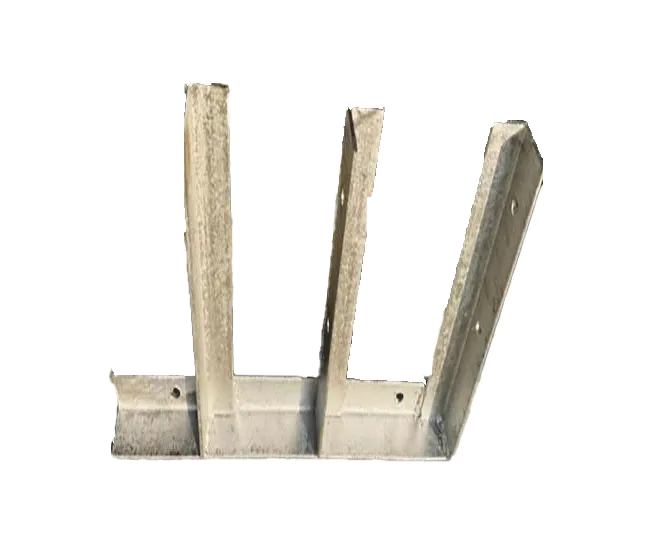Products Description
Galvanized Water Pipe Brackets: Dual Guarantee for Pipeline Stability and Anti-Corrosion
In the installation of water supply and drainage systems, heating and ventilation pipelines and other engineering projects, the fixing and support of pipelines are directly related to the safety and service life of the system. Galvanized water pipe brackets, as supporting components specially designed for water pipes, with the anti-corrosion performance and structural stability endowed by the galvanizing process, have become indispensable auxiliary facilities in various pipeline laying projects, providing reliable mechanical support for water pipes while resisting environmental erosion.
I. Materials and Processes: Core Advantages of Anti-Corrosion and Durability
Galvanized water pipe brackets are based on mild steel and treated by hot-dip galvanizing or electro-galvanizing processes to form a tightly attached zinc coating. This process characteristic endows them with multiple advantages:
- Excellent anti-corrosion performance: The zinc coating, as a sacrificial anode, can be oxidized preferentially over steel, forming a dense zinc oxide protective film, which effectively isolates moisture, oxygen and corrosive media from eroding the steel. It is especially suitable for humid environments (such as bathrooms, basements), outdoor exposed pipelines or places with slight corrosion (such as auxiliary water pipes in chemical workshops);
- High strength and rigidity: The mild steel base material itself has good load-bearing capacity. Brackets made through stamping, welding and other processing techniques can stably bear the weight of water pipes with different diameters, as well as additional stresses caused by water flow impact and temperature changes;
- Smooth surface and easy maintenance: The galvanized layer makes the surface of the bracket flat and smooth, not easy to accumulate dirt, and daily cleaning is simple. Moreover, the zinc layer is firmly combined with the steel, not easy to fall off, and the service life is much longer than that of ordinary non-galvanized brackets.
II. Core Uses: The "Load-Bearing Skeleton" of the Pipeline System
The core function of galvanized water pipe brackets is to provide stable support and fixation for water pipes, ensuring that the pipelines maintain the preset position and slope during installation and use. The specific roles are reflected in:
- Load-bearing and anti-displacement: Through the rigid support of the bracket, the weight of the water pipe is evenly transmitted to the load-bearing foundations such as walls, floors or steel structures, preventing the water pipe from sagging, bending or shifting due to its own weight, and avoiding leakage caused by loose interfaces;
- Guiding and limiting: In hot water pipeline systems, the bracket can limit the excessive displacement of the water pipe caused by thermal expansion and contraction, reduce the stress between the pipeline and the fixed end, and protect weak parts such as valves and joints;
- Regular layout: Through the installation of brackets with uniform specifications, the pipelines are arranged neatly and orderly, which is convenient for later maintenance, repair and system expansion. Especially in dense laying scenarios such as pipe wells and ceilings in large buildings, it can significantly improve space utilization and aesthetics.
Its application scenarios widely cover civil and industrial fields, including residential water supply and drainage pipelines, air-conditioning water pipes in commercial buildings, municipal pipe network branches, factory circulating water systems, etc.
III. Structural Types and Adaptive Design
According to the installation method and stress requirements of water pipes, common structural types of galvanized water pipe brackets include:
- Bracket-type brackets: In the shape of "U" or "L", they directly support the bottom of the water pipe, suitable for horizontally laid pipelines, and can be fixed on walls or floors with expansion bolts;
- Hanger-type brackets: Composed of suspenders and brackets, they are hung from the ceiling or beams, used for fixing horizontal pipelines in ceilings or at high altitudes, and can save ground space;
- Wall-mounted brackets: Fixed on the wall through a flat base, supporting vertical pipelines on the side or top to ensure the verticality and stability of the riser;
- Combined brackets: Composed of multiple unit components spliced together, they can be flexibly adjusted according to the number and spacing of pipelines, suitable for scenarios where multiple pipelines are laid in parallel.
The specifications of the bracket (such as steel thickness, bracket arm length, load-bearing capacity) need to match the diameter of the water pipe. For example, a DN50 water pipe usually adapts to a bracket with a load-bearing capacity of more than 50kg, and a large-diameter pipeline with DN100 and above needs to use a thickened bracket or combined support to ensure the safety factor.
IV. Installation Advantages and Long-Term Value
Compared with ordinary steel brackets or brackets of other materials, galvanized water pipe brackets have significant advantages in installation and use:
- Convenient installation: Most brackets are standardized prefabricated parts with reserved holes, which can be quickly fixed directly with bolts and expansion screws, reducing on-site processing links;
- Low maintenance cost: The anti-corrosion property of the galvanized layer greatly reduces the probability of bracket rust and damage, reduces regular maintenance work such as derusting and painting, and prolongs the maintenance cycle of the system;
- Strong compatibility: It is not only suitable for galvanized steel pipes, but also can be matched with plastic pipes such as PPR pipes and PE pipes (a rubber pad needs to be installed between the bracket and the pipe to avoid cold bridges or wear), adapting to various pipe systems.
From the perspective of long-term use, although galvanized water pipe brackets increase the initial material cost, they can significantly reduce the whole life cycle cost by reducing the frequency of repair and replacement and extending the life of the pipeline system, making them an economical and durable choice.
Summary
Although galvanized water pipe brackets are "supporting roles" in the pipeline system, they have become the "invisible cornerstone" to ensure the safe operation of water pipes with their anti-corrosion and durable materials and stable and reliable support performance. It combines structural mechanics and anti-corrosion technology, which not only solves the problem of pipeline fixing, but also resists the challenge of environmental erosion. In complex construction and industrial environments, it silently guards the smooth flow of water and the stability of the system, and is an indispensable practical component in modern pipeline engineering.



